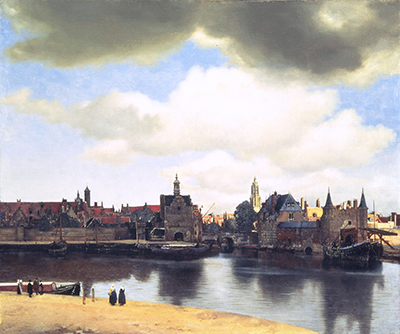Vermeer's View of Delft is regarded by many art critics as one of the most exquisite cityscapes ever produced. In fact, it is sometimes hard to think of the scene as a flat cityscape.
The artist draws viewers into the scene with his lush interpretation of the place of his birth. The water relaxes viewers as they gaze on spirals of buildings which reach towards the beautifully lit sky.
Delft has been rendered with the care Vermeer is known for. Perhaps a little bit of extra attention is given to the theme because it is his hometown. The sketch of the Dutch craftsman's main residence is among his most popular.
It was painted when cityscapes were unprecedented. Certainly, the skill evident in its portrayal is at a level to which many artists of his time and artists of today would aspire.
The View of Delft was Vermeer's biggest and most tedious work. The only exception to that may be the detailed Art of Painting. Since nothing has been given to contemporary viewers concerning the craftsman's goals in respect to this or some of Vermeer's other artwork, history specialists have endeavoured to fill the space with their own interpretation of the piece.
Walter Liedtke, has stated that the painting could have been requested by Vermeer's supporter, Pieter van Ruijven. This patron had supported the greater part of the craftsman's masterful creations. Besides, Liedtke brings up that the works which were sponsored by Van Ruijven's contained three other minute scale cityscapes of Delft by Vermeer.
His collection also includes three works of art by Emanuel de Witte, including an energetic perspective of William the Silent's tomb in the Nieuwe Kerk. Vermeer staggeringly highlighted that perspective in his View of Delft.
Dutch subjects emphatically connected with their republic, as well as with their city of birth. Their city pride is affirmed nowadays by endless Dutch cityscapes. The patriotism and love evident in the view of Delft has helped to make it one of the most popular paintings of that type of subject. The painting has been featured in other creative works as well, including a novel by Marcel Proust.
View of Delft is unmistakably masterful and it is one of the most convincing cityscapes a viewer may ever see. It has a mind-boggling nearness, passing on the observation that you are viewing a cityscape which is even more genuine than real life. Vermeer uses colours in a way that makes the painting of Delft more significant than anything you could experience in the outside world.
One of the delights of Vermeer's specialty is its openness. You can remain in awestruck wonder before this artistic creation without analysing it. Unlike some paintings, you do not have to work hard to comprehend it on a scholarly level. You can just value its beauty.
Vermeer could realise such an extreme impact on each viewer through his use of lighting. Dull mists overhanging the city cast the forefront in shadow. This not just points out the limitlessness of the sky, yet serves to draw the eye into the heart of the city, which is washed in warm daylight. Vermeer additionally applied different textures to pass on the physical nearness of Delft.
Foreseeing Georges Braque by over 200 years, he mixed sand with the paint used to render the stone veneers, scaffold and rooftops. In the tallest tower, Vermeer connected a thick impasto of yellow to complement the sunlit ranges.
This painting of Delft is the main composition of Vermeer that fits examination with a known theme. All things considered, it offers significant understanding into his inventive method. Investigation of contemporary land drawings and artistic creations of Delft uncovers that Vermeer uninhibitedly balanced the cityscape in light of a legitimate concern for his piece. He rolled out various improvements that smoothed the cityscape, strengthening its frieze-like profile.
His perspective of Delft mirrors Vermeer's idea of excellence and the conspicuous holy places could be an unpretentious fortification of Christian ethics of this time. It could likewise be that by painting the Old Church in shadow and the New Church in daylight that he was depicting the city's otherworldly development. Along with The Little Street, View of Delft is one of the few paintings that Vermeer completed outside.




